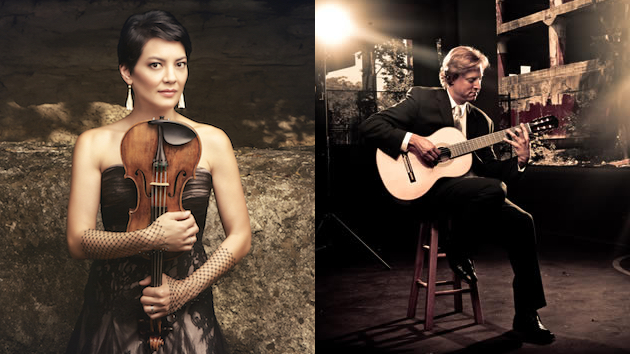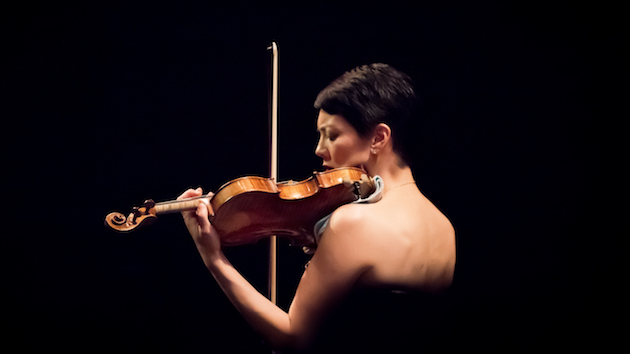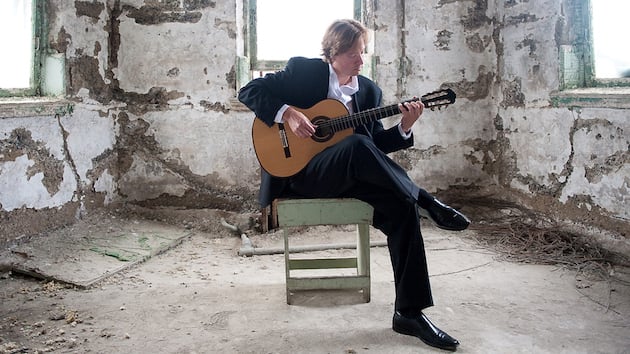
Anne Akiko Meyers is a dazzling violinist with flawless technique, impassioned playing, a high-gloss violin, and even a voluminous Cinderella evening gown that easily covers a square yard of stage. She is impossible to miss.
To all that add an adventurous repertoire and a brilliant guitar accompanist, Jason Vieaux, and you have a surefire formula for a memorable evening. Such was the case on Saturday, when Meyers and Vieaux displayed their formidable talents to an appreciative audience at Sonoma State’s Green Music Center, playing works by Arcangelo Corelli, Philip Glass, Astor Piazzolla, Rentaro Taki, Antônio Carlos Jobim, John Corigliano, and Manuel de Falla.
Pianos are the usual accompaniment for violin recitals, but the classical guitar is well suited to certain repertoire, particularly Spanish and Latin American, where the guitar is king. As Vieaux proved, guitar was also perfectly suited to the rest of the music.

The main drawback to using a classical guitar as accompaniment is the acoustic imbalance between the bright, projecting violin and the subdued, quiescent guitar. Vieaux solved this problem by using a stand-alone microphone that subtly amplified the guitar without overwhelming the violin.
Meyers and Vieaux, both of whom played mostly from score, began the festivities with a modernized version of Corelli’s “La Folia” (madness) sonata, one of the hallmarks of the Baroque violin repertoire. Meyers displayed a gorgeous tone and a warm vibrato from the outset, moving easily through about a dozen increasingly difficult variations on the opening melody. Vieaux was a perfect foil as Meyers unleashed a dizzying array of pizzicatos, double stops, saltatos (jumping bows), and glissandos. The last variation entailed furious bow motion, with several dangling bow hairs adding to the effect.
Fresh from her mad scene, Meyers segued into a soothingly contemplative transcription of Metamorphosis II by Philip Glass. Originally written for piano, the piece works well as a duet, with the guitar playing Glass’s trademark repetitive arpeggios and the violin lingering on the long vocal lines. The music was relatively static, but it always felt like it was going somewhere, thanks to Meyers’ irresistible forward momentum. Midway through, Meyers switched from sustained notes to bowing rapidly back and forth across all four strings (bariolage). The effect was hypnotic.
The high point arrived with Piazzolla’s Histoire du Tango, a tour de force for both violin and guitar that demands incredible dexterity and rhythmic flexibility. Written in 1986, the four-movement work truly is a history of the tango, beginning in Argentinean bordellos in the 1880s, moving through cafe society in the 1930s, night clubs in the 1960s, and culminating in a modern version that blends influences from around the world.

Piazzolla wrote Histoire du Tango for guitar and flute, so the transition to violin is seamless. The history begins way up on the violin, with strong syncopations and intricate bowing and fingering. Meyers really leaned into the tango beat while traversing the fingerboard dance floor in nanoseconds. Vieaux began the second movement with languid, aching melodies coupled to an insistent beat. Meyers bent her solo lines like a human voice, sliding into notes and connecting them with the greatest of care. Her sound became increasingly intimate, with a miraculous pianissimo at the end.
The last two movements returned to brilliant virtuosity from both players, alternating with plangent melodies. Meyers added ponticello (on the bridge) playing to her repertoire, even sneaking behind the bridge to produce a particularly eerie sound. Her bow control was stupendous as she whirled through the fiery prestissimo at the end.
After intermission, the mood relaxed again, with two lullabies with evocative melodies: 19th-century Japanese composer Rentaro Taki’s The Moon over the Ruined Castle, and John Corigliano’s Lullaby for Natalie. Corigliano’s piece was written for Meyers’ daughter, so the performance was especially heartfelt.
Vieaux got the solo spotlight in Antônio Carlos Jobim’s “A Felicidade,” the opening tune from his classic soundtrack for the movie Black Orpheus (1959). Staring steadily at his left hand, Vieaux offered a flawless performance, devoid of squeaking frets or misplaced notes. His beat was remarkably steady, and his melodic flair engaging.
In five of Manuel de Falla’s familiar Siete Canciones Populares Espanolas (Seven popular Spanish songs), Meyers again played like a vocalist, bending each passionate line to dramatic effect. All led to a torrential conclusion marked by insistent growls from her lower strings.
The encore was an out-of-the-blue rendition of Elvis Presley’s “Can’t Help Falling in Love.” And it’s true. What was not to love?




